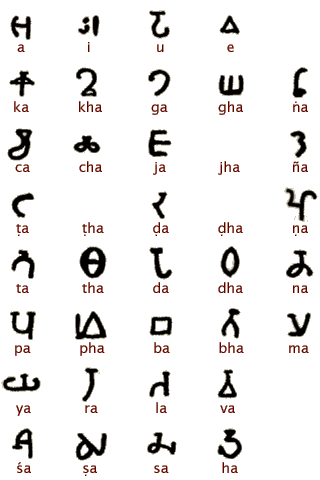For the content of my website I have chosen to look into the history of the alphabet/writing systems and do an evolution from the first alphabet through to our current one. To be able to do this well I need a good understanding into the history of type and writing in general. I started by looking at the alphabets in general, with their different characteristics and styles, before narrowing it down to what I wanted to look into.
- There are only five completely independent writing systems that have been produced in history. Sumerian, Egyptian, Harappan, Mayan & Chinese.
- Of these five, the only one still used in the modern day is Chinese.
- The oldest is believed to be the Sumerian.
There are a number of types of writing systems. These are dependent on the way they represent their underlying languages.
- Logographic
- Logophonetic
- Syllabic
- Consonantal Alphabet (Abjad)
- Syllabic Alphabet (Abugida)
- Segmental Alphabet
Logophonetic
Syllabic
Consonantal Alphabet
Syllabic Alphabet
Segmental Alphabet
Types of Cuneiform
Sumarian
Akkadian
Hittite
Ugaritic
Old Persian
After going through these different writing systems, I have decided to go with Sumerian and Cuneiform as this is the oldest recorded writing system.
- Cuneiform is one of the earliest known systems of writing, distinguished by it's wedge-shaped marks.
- It emerged in Sumer in the 4th millennium BC.
- It began as a series of pictographs.
- In the 3rd millennium these pictographs were simplified and became more abstract.
- The original Sumarian script was adapted for the writing of eight languages and inspired two languages.
Development of SAG 'head' over two millennia:
Phonogram: a symbol representing a vocal sound.
Logograms: a sign or character used to represent a word or phrase
Determinatives: a thing that determines or decides something.
Sumarian
- The Sumerians were one of the earliest urban societies to emerge in the world, in Southern Mesopotamia more than 5000 years ago. They developed a writing system whose wedge-shaped strokes would influence the style of scripts in the same geographical area for the next 3000 years. Eventually, all of these diverse writing systems, which encompass both logophonetic, consonantal alphabetic, and syllabic systems, became known as cuneiform.
- The original direction of writing was from top to bottom, but for reasons unknown, it changed to left-to-right. This also affected the orientation of the signs by rotating all of them 90° counterclockwise. Another change in this early system involved the "style" of the signs. The early signs were more "linear" in that the strokes making up the signs were lines and curves. But starting after 3000 BCE these strokes started to evolve into wedges.
- By 2800 BCE the writing system started to exhibit use of phonetic elements due to the large amount of words that sounded similar.
- There where many words that have similar meaning but vastly different sounds are written with the same sign. For example, the word zu "tooth", ka "mouth", and gu"voice" are all written with the sign for gu3 "voice".
- In addition to use of phonetic signs to spell out new words, new signs were created by adding graphic elements to an existing sign or combining two existing signs. The additional graphic element could be geometric patterns without any meaning, or could be another cuneiform sign.
Akkadian
- While the cuneiform writing system was created and used at first only by the Sumerian, it did not take long before neighboring groups adopted it for their own use. By 2500 BCE, the Akkadians starting using cuneiform to write their own language.
- Sumerian and Akkadian are vastly different languages. Sumerian is a more agglutinative language, where phonetically unchanging words and particles are joined together to form phrases with increasingly complex meaning. Akkadian, however, is infectional, meaning that the basic form of a word, called a root, can be modified in a myriad of ways to create words of related but different meanings.
Hittite
- Hittite adopted theAkkadian cuneiform to write their language. Approximately 375 cuneiform signs were adopted from Akkadian cuneiform. As in Akkadian, signs can be roughly categorized into phonograms, logograms, and determinatives.
- Phonograms are signs used for their phonetic values. They can be a single vowel, a consonant followed by a vowel, or a vowel followed by a consonant.
- In addition to phonograms, Hittite also employed a number of logograms. Many phonograms also serve as logograms, and many logograms have multiple meanings as well.
- Quite often logograms are accompanied by phonetic complements, phonograms that serve to disambiguate the reading of logograms and/or to explicitly write out inflectional ending of the word.
Ugaritic
- The Ugaritic script was really one of a kind, for it was a cuneiform alphabet. Clay tablets written in Ugaritic provided the first evidence of the "modern" ordering of letters, which in Ugaritic went like 'a, b, g, and so on, that eventually gave the order of letters in the Greek and Roman abecedaries.
Old Persian
- Early in the history of the dynasty, a syllabic script to write the Old Persian language was developed. This script was not a direct descendent of the Sumerian and Akkadian systems, because even though the physical appearance of Old Persian signs are Cuneiform, or in the shape of wedges, the actual shape of the signs do not correspond to signs in older systems with similar phonetic values. Old Persian only kept the cuneiform appearance of its characters simply out of tradition, and the actual shape of the signs were completely original.
- Old Persian is classified as a syllabic script.
- These are the logograms used in Old Persian.
- A slanted vertical wedge is used as the separator between words.



















No comments:
Post a Comment